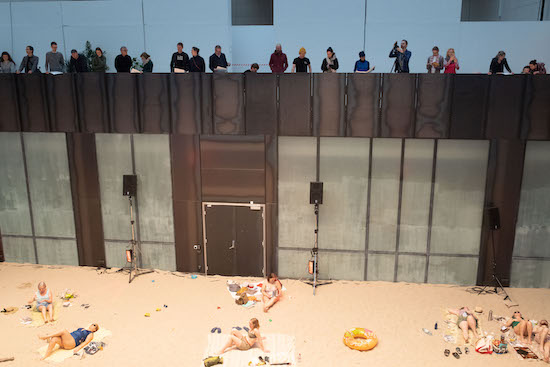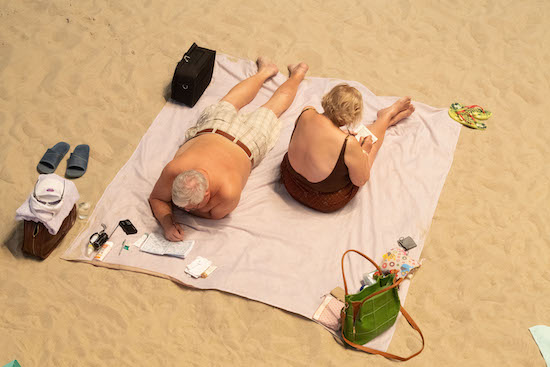Photo by Johanne Karlsrud
It’s the beginning of March and I’m at a music festival in Norway. There are still only eighty-seven known cases of coronavirus in the UK and even fewer over here. The WHO has yet to declare the disease an official “pandemic”. But if the gravity of the present situation had scarcely registered when I flew out from Gatwick three days ago, then the sight of bottles of hand sanitiser and notices outside every venue offering helpful advice on “habits which help prevent infection” is certainly helping it to sink in. I’m standing on a concrete balcony in the middle of a large municipal building on the south-east edge of Bergen and I’m looking down. I’m looking down over the edge of the balcony onto a beach.
Several tons of imported sand fill the central atrium of the building. There are brightly coloured beach towels and picnic blankets, scattered flip-flops, plastic buckets, rubber rings, a few bicycles leaning to. Roughly 34 people, young and old, including a few small children, laze about reading, chatting, idly snacking or looking at their phones, playing beach ball or badminton. I can hear the sound of faint laughter and light conversation. Even the loudspeakers – eight of them, around the sides, facing in – look relaxed.
The music playing is mostly a single synth line, like an organ sound, with occasional ornaments of twinkling synth percussion. And amongst the assorted beach bums, there are singers – though you wouldn’t immediately guess which. The characters in this opera – and it is an opera, no less so than Orfeo ed Euridice or Le nozze di Figaro – are at first indistinguishable from the background cast, many of whom are local people who have volunteered to spend a day or so indoors on an artificial beach, peered down at by spectators (this morning, that background cast also includes the two directors of the music festival I’m attending, in their swimwear, accompanied by their children). They sing about being tired, about their work, their dreams, their spouses, their children, complain about the litter.
A character known as the ‘Wealthy Mommy’ sings of her elaborate global holidays and all the different seas her eight year-old child has already swum in. The ‘Philosopher’ – a bespectacled woman in khaki shorts singing as she lies on a striped mat – passes ironic commentary on the global circulation of goods. Heat lamps blaze. A trio in caps and straw hats stroke the belly of a russet-furred dog.
At the Venice Biennale in 2019, Sun & Sea (Marina), a work composed by Lina Lapelytė to a libretto by Vaiva Grainytė with scenography by Rugilė Barzdžiukaitė, won the Golden Lion for best national pavilion. There were queues to get in round the block. The New York Times praised its “poetic obliqueness” and “haunting simplicity”. The Guardian named it the year’s second best work of art. Starting here in Bergen, the work begins a world tour that is due to take it to a dozen or more venues from New York to Brazil to Australia to South Korea – or at least it was, before the world’s airlines and art institutions ground to a halt under threat from a flu-like virus which has now killed close to 150,000 people worldwide. For now, presumably, everything is on hold (like everything else).
“The piece had this weird crossover where it somehow got into the wider public consciousness,” curator Lucia Pietroiusti tells me when I meet with her and Lapelytė one day in Bergen. “It did those things that art works don’t usually do.”

Photo by Thor Brødreskift
It’s easy to see why Sun & Sea was such a hit at Venice. The work is enormously pleasant company. It feels nice to be around. Like Robert Ashley or Laurie Anderson, the music is rarely harsh or grating but it is deceptively complex in design, witty, allusive, beautifully executed. And the more time you spend with it, the more layers it reveals to you. Little details become apparent, and you get to feel like you have found them for yourself somehow – rather than had them explicitly pointed out to you by the work itself in some way.
Like the vast quantity of plastic strewn about – plastic ships and cups and paddles and frisbees and water bottles and snorkels and tupperware and buckets and spades – much of it seemingly abandoned (and is that a deflated beach ball, patterned to resemble the earth crumped up in the middle?). The strange absence of any water, or even the sound of water. The lack of shadows – those harsh floodlights rendering the space a permanent noon. The indiscernibility of the moment it loops (the work lasts around an hour, but performances go on all day, on repeat). Like Buñuel’s Exterminating Angel, this is a party that no-one can ever leave. A perfectly static utopia – or hell.
Writing in the London Review of Books from Venice, Daisy Hildyard noted that the “Topera belongs to a rare species of ecological writing in that it involves something recognisable as normal life … Where it refers directly to climate change,” she continued, “it does so only lightly or at a slant.” Nonetheless, the narrative that here was a work in some sense ‘about’ the ongoing climate crisis was cemented by reviewers from the New York Times, The Guardian, and Frieze. But as Lapelytė was keen to stress to me, “it’s not just climate change. There’s body politics, many other layers…”
“We were very cautious of the topic, in general,” she says, when I ask about the early gestation of the piece. “When we showed it first in Lithuania, we thought that no-one is going to get these underlying messages that are in-between the lines, like a woman singing about her travels to see the coral reefs. But then when you join them all together…”
Six weeks ago as I tramped through the rain in Bergen, bumped into old friends and joked about whether it was still ok to hug hello, I worried about having anything to say on this work about which it seemed everything had already been said. All the proper art critics had seen it at Venice a year ago and decided what it was about. The line was set down. So I started to think about what it meant to take a work like this on tour. How do you take a beach on the road? And how do you grapple with the environmental implications of touring a large-scale work of live art when the work itself is, at least in part, about our own casual blindness to the environmental implications of our actions?
And Lapelytė and Pietroiusti both talked engagingly about re-using the sand to build children’s playgrounds on the outskirts of Venice, working with a co-operative of inmates from a local prison to screen print the vinyl records, carbon off-setting their flights, using local people and props – even local sand – in the different places they will take the work to, and generally trying to stay mindful of the environment. “But it’s not that the piece is saying kind of a didactic thing, we should not do this and then we do this,” Lapelytė cautioned. “We are criticising ourselves. We also belong to that circle of consuming.”
And we spoke about the practicalities of touring such a work. The trickiness of finding a venue with the right kind of architecture for the set-up. The subtle differences between working with art institutions and music venues. What Lapelytė called the “fluidity” of the work.
But a month and a half later, after spending weeks in lockdown, scarcely leaving my own flat and not venturing outside my particular London borough, after cancelled trips and only seeing friends through a screen and days spent wondering if and when we might ever be able to travel again, then suddenly the image of a beach in a box, a sandpit in the atrium of a large concrete building, bathers tanned by lamps lying on sand shipped in from another town 200 kilometres away, starts to look like something different. It starts to mean something different that didn’t really occur to me at the time. It certainly does not mean less. The planes may be grounded (most of them), the skies may be clearer, but Amazon.com is reporting record profits and just last week a party of rich Brits – men in their late 40s and women in the early 20s – had to be turned away from Marseille-Provence airport after they chartered a private plane in the hope of escaping to the Côte d’Azur.

Photo by Thor Brødreskift
In her essay for the booklet that comes with the vinyl record of Sun & Sea’s music, Pietroiusti recalls the animated sugar bowl in the Disney film, Sword in the Stone, which keeps on adding sugar to Merlin’s tea cup long after it has begun to overflow. “Everything is upside down. Everything is transformed, and yet the garbage can will not stop producing garbage, and you and I only have a cartoon sorcerer’s piece of crockery to tell us that this is the spell we are putting on the planet – with all the possible spells at our disposal, this is the one we choose to cast.”
Talking to Lina Lapelytė in Bergen, she recalled to me the beaches of her childhood. “In Lithuania we have ninety kilometres of beach in total,” she said. “So it’s not that much. And we have these beaches with very bright sand, very light – almost white sand. And it’s like where you meet… everyone. Regardless of class. You meet your university professor, you meet your next door neighbour. It’s a place where everyone goes in the summer.” Except this summer the British police are harassing anyone who stops for five minutes to take a break from their one daily mandated piece of exercise.
As much as it is about all the other things it is about, Sun & Sea is also about what people think about when they are on their own. The characters in this opera do not really interact. There are few duets and no trios. And their individual arias do not add up to a ‘plot’ in any conventional sense. There is no action, no conflict. Instead, they worry, they ponder. One man recalls a dream in which he is the guest of an author who complains of a tumour “the size of an egg” which can only be assuaged by the consumption of large quantities of shrimp. “I’ve never had a stranger dream!” he marvels. Sun & Sea is a strange dream about a beach. And right now – for the foreseeable future – a dream of a beach may be the only beach we’ve got.


